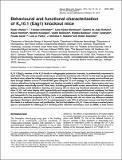Por favor, use este identificador para citar o enlazar a este item:
http://hdl.handle.net/10261/288791COMPARTIR / EXPORTAR:
 SHARE SHARE
 CORE
BASE CORE
BASE
|
|
| Visualizar otros formatos: MARC | Dublin Core | RDF | ORE | MODS | METS | DIDL | DATACITE | |

| Título: | Behavioural and functional characterization of Kν10.1 (Eag1) knockout mice |
Autor: | Ufartes, Roser; Schneider, Tomasz; Sünke Mortensen, Lena; Juan Romero, Camino de CSIC ORCID; Hentrich, Klaus; Knoetgen, Hendrik; Beilinson, Vadim; Moebius, Wiebke; Tarabykin, Victor; Alves, Frauke; Pardo, Luis A.; Rawlins, J. Nicholas P.; Stuehmer, Walter | Fecha de publicación: | 2013 | Editor: | Oxford University Press | Citación: | Human Molecular Genetics 22(11): 2247-2262 (2013) | Resumen: | Kv10.1 (Eag1), member of the Kv10 family of voltage-gated potassium channels, is preferentially expressed in adult brain. The aim of the present study was to unravel the functional role of Kv10.1 in the brain by generating knockout mice, where the voltage sensor and pore region of Kv10.1 were removed to render non-functional proteins through deletion of exon 7 of the KCNH1 gene using the ‘3 Lox P strategy’. Kv10.1-deficient mice show no obvious alterations during embryogenesis and develop normally to adulthood; cortex, hippocampus and cerebellum appear anatomically normal. Other tests, including general health screen, sensorimotor functioning and gating, anxiety, social behaviour, learning and memory did not show any functional aberrations in Kv10.1 null mice. Kv10.1 null mice display mild hyperactivity and longer-lasting haloperidol-induced catalepsy, but there was no difference between genotypes in amphetamine sensitization and withdrawal, reactivity to apomorphine and haloperidol in the prepulse inhibition tests or to antidepressants in the haloperidol-induced catalepsy. Furthermore, electrical properties of Kv10.1 in cerebellar Purkinje cells did not show any difference between genotypes. Bearing in mind that Kv10.1 is overexpressed in over 70% of all human tumours and that its inhibition leads to a reduced tumour cell proliferation, the fact that deletion of Kv10.1 does not show a marked phenotype is a prerequisite for utilizing Kv10.1 blocking and/or reduction techniques, such as siRNA, to treat cancer. | Versión del editor: | https://doi.org/10.1093/hmg/ddt076 | URI: | http://hdl.handle.net/10261/288791 | DOI: | 10.1093/hmg/ddt076 | ISSN: | 0964-6906 |
| Aparece en las colecciones: | (IN) Artículos |
Ficheros en este ítem:
| Fichero | Descripción | Tamaño | Formato | |
|---|---|---|---|---|
| Eag1.pdf | 785,54 kB | Adobe PDF |  Visualizar/Abrir |
CORE Recommender
PubMed Central
Citations
24
checked on 19-may-2024
SCOPUSTM
Citations
44
checked on 19-may-2024
WEB OF SCIENCETM
Citations
40
checked on 29-feb-2024
Page view(s)
21
checked on 21-may-2024
Download(s)
13
checked on 21-may-2024

